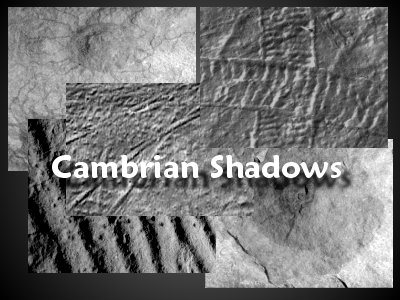|
-
Hagadorn, JW.,
Dott, RH., Damrow, D, Stranded on a Late Cambrian shoreline: Medusae from
central Wisconsin, Geology (39) No. 2.
-
Getty,
P. R.; Hagadorn, J. W. (2009). "Palaeobiology of the Climactichnites
tracemaker". Palaeontology 52 (4): 753–778
-
Damrow,
Daniel F, Lipps, Jere H., and Gershwin, Lisa-ann (2001) Is Climactichnites
Really a Trace Fossil?, Geological Society of America Annual Meeting, November
5-8, 2001.
-
Getty,
P. R. (2006). "Producing And Preserving Climactichnites".
Geological Society of America Abstracts with Programs 38 (7): 475
-
Getty,
P. R.; Hagadorn, J. W. (2008). "Reinterpretation of Climactichnites Logan
1860 to Include Subsurface Burrows, and Erection of Musculopodus for Resting
Traces of the Trailmaker". Journal of Paleontology 82 (6): 1161–1172.
-
Getty
P. R. (2007) (masters thesis). Paleobiology of the
Climactichnites Trackmaker: An Enigmatic Late Cambrian
Animal Known
Only from Trace Fossil
-
Yochelson,
E. L., and Fedonkin, M. A. (1993) "Paleobiology of Climactichnites,
an Enigmatic Late Cambrian Fossil." Smithsonian
Contributions to Paleobiology Number 74, Washington,
D. C.: Smithsonian Institution
Press.
Hagadorn, J. W., and Seilacher, A., Hermits 500 million years ago?: Geology 37(4),
295-298 (2009).
- Collette, J. H., K. C. Gass & J. W. Hagadorn (2012). "Protichnites
eremita unshelled? Experimental model-based neoichnology and
new evidence for a euthycarcinoid affinity for this ichnospecies".
Journal of Paleontology 86 (3): 442–454.
- Collette, J. H. & J. W. Hagadorn (2010). "Three-dimensionally
preserved arthropods from Cambrian Lagerstatten of Quebec and
Wisconsin". Journal of Paleontology 84 (4): 646–667.
- Hagadorn, J. W., and A. Seilacher (2009). "Hermit arthropods
500 million years ago?". Geology 37 (4): 295–298.
- Hoxie, C. T. (2005). "Late Cambrian arthropod trackways
in subaerially exposed environments: Incentives to simplify
a problematic ichnogenus". Unpublished B.A. Thesis: 1–89.
- Hesselbo, S. P. (1989). "Trace fossils of Cambrian aglaspidid
arthropods". Lethaia 21 (2): 129–146.
- C. T. Hoxie & J. W. Hagadorn (2005). "Late Cambrian
arthropod trackways in subaerially exposed environments".
Geological Society of America Abstracts with Programs, Northeastern
Section 37: 12.
- Ortega-Hernandez, J., Tremewan, J., & Braddy, S. J. (2010). "Euthycarcinoids".
Geology Today 26 (5): 195–198.
-
Owen,
R. (1852). "Description of the impressions
and footprints of the Protichnites from the Potsdam sandstone
of Canada". Geological Society of London
Quarterly Journal 8: 214–225.
- Owen, R. (1851). "Description of the impressions on
the Potsdam sandstone, discovered by Mr. Logan in Lower Canada".
Geological Society of London Quarterly Journal 7: 250–252.
-
Anderson,
L. I., Dunlop, J. A., Horrocks,
C. A., Winkelmann, H. M. & Eagar, R.
M. C. 1997. Exceptionally preserved fossils
from Bickershaw, Lanacashire,
UK (Upper Carboniferous, Westphalian
A (Langsettian)). Geological
Journal, 32: 197-210.
-
Frederick
R. Schram and Stefan Koenemann, Developmental genetics
and arthropod evolution: part I, on legs, Evolution & Development (3)
5 Page 343 - September/October 2001.
-
MacNaughton,
R. B et al. First steps on land: Arthropod trackways
in Cambrian-Ordovician eolian sandstone, southeastern
Ontario, Canada. Geology, 30, 391 - 394, (2002).
-
McNamara,
K. J. & Trewin, N. H. 1993. A euthycarcinoid
arthropod from the Silurian of Western
Australia. Palaeontology,
36: 319-335.
-
Vacarri,
N.E., Edgecombe G.D. and Escudero C., (2004) Cambrian
origins
and affinities of an enigmatic fossil group of arthropods,
Nature 430, 554 - 557.
- Ortega-Hernandez,
J., Tremewan, J., & Braddy, S. J. (2010). "Euthycarcinoids".
Geology Today 26 (5): 195–198
|
